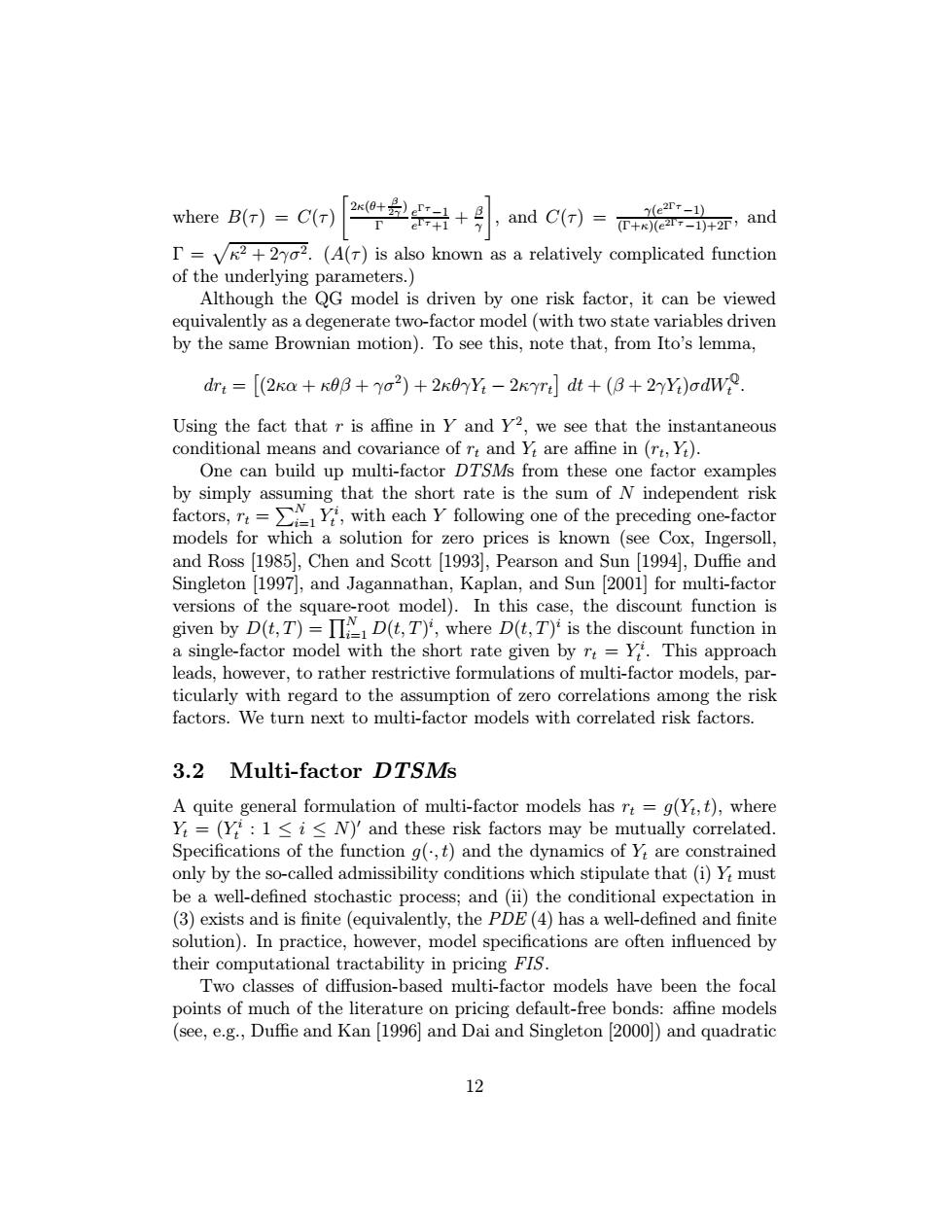正在加载图片...

where B(r)=C(r) 出+引 x(e2rT-1) and C(T)=(re-1)+2r,and I=VK2 +2o2.(A(T)is also known as a relatively complicated function of the underlying parameters.) Although the QG model is driven by one risk factor,it can be viewed equivalently as a degenerate two-factor model(with two state variables driven by the same Brownian motion).To see this,note that,from Ito's lemma, dr:=[(2ka+n08+Yo2)+2k0yY:-2kYr:]dt +(B+2yYi)odw. Using the fact that r is affine in Y and Y2,we see that the instantaneous conditional means and covariance of r:and Yi are affine in (rt,Yi). One can build up multi-factor DTSMs from these one factor examples by simply assuming that the short rate is the sum of N independent risk factors,with eachY following one of the preceding one-factor models for which a solution for zero prices is known (see Cox,Ingersoll, and Ross [1985],Chen and Scott [1993],Pearson and Sun [1994],Duffie and Singleton [1997],and Jagannathan,Kaplan,and Sun 2001]for multi-factor versions of the square-root model).In this case,the discount function is given by D(t,T)=IIND(t,T),where D(t,T)i is the discount function in a single-factor model with the short rate given by r=Y.This approach leads,however,to rather restrictive formulations of multi-factor models,par- ticularly with regard to the assumption of zero correlations among the risk factors.We turn next to multi-factor models with correlated risk factors. 3.2 Multi-factor DTSMs A quite general formulation of multi-factor models has rt=g(Yi,t),where Y=(Y:1<i<N)'and these risk factors may be mutually correlated. Specifications of the function g(,t)and the dynamics of Yi are constrained only by the so-called admissibility conditions which stipulate that (i)Yi must be a well-defined stochastic process;and (ii)the conditional expectation in (3)exists and is finite (equivalently,the PDE(4)has a well-defined and finite solution).In practice,however,model specifications are often influenced by their computational tractability in pricing FIS. Two classes of diffusion-based multi-factor models have been the focal points of much of the literature on pricing default-free bonds:affine models (see,e.g.,Duffie and Kan 1996 and Dai and Singleton 2000)and quadratic 12where B(τ ) = C(τ ) 2κ(θ+ β 2γ ) Γ eΓτ−1 eΓτ+1 + β γ , and C(τ ) = γ(e2Γτ −1) (Γ+κ)(e2Γτ −1)+2Γ, and Γ = pκ2 + 2γσ2. (A(τ ) is also known as a relatively complicated function of the underlying parameters.) Although the QG model is driven by one risk factor, it can be viewed equivalently as a degenerate two-factor model (with two state variables driven by the same Brownian motion). To see this, note that, from Ito’s lemma, drt = (2κα + κθβ + γσ2 )+2κθγYt − 2κγrt dt + (β + 2γYt)σdWQ t . Using the fact that r is affine in Y and Y 2, we see that the instantaneous conditional means and covariance of rt and Yt are affine in (rt, Yt). One can build up multi-factor DTSMs from these one factor examples by simply assuming that the short rate is the sum of N independent risk factors, rt = PN i=1 Y i t , with each Y following one of the preceding one-factor models for which a solution for zero prices is known (see Cox, Ingersoll, and Ross [1985], Chen and Scott [1993], Pearson and Sun [1994], Duffie and Singleton [1997], and Jagannathan, Kaplan, and Sun [2001] for multi-factor versions of the square-root model). In this case, the discount function is given by D(t, T) = QN i=1 D(t, T)i , where D(t, T)i is the discount function in a single-factor model with the short rate given by rt = Y i t . This approach leads, however, to rather restrictive formulations of multi-factor models, particularly with regard to the assumption of zero correlations among the risk factors. We turn next to multi-factor models with correlated risk factors. 3.2 Multi-factor DTSMs A quite general formulation of multi-factor models has rt = g(Yt, t), where Yt = (Y i t : 1 ≤ i ≤ N)0 and these risk factors may be mutually correlated. Specifications of the function g(·, t) and the dynamics of Yt are constrained only by the so-called admissibility conditions which stipulate that (i) Yt must be a well-defined stochastic process; and (ii) the conditional expectation in (3) exists and is finite (equivalently, the PDE (4) has a well-defined and finite solution). In practice, however, model specifications are often influenced by their computational tractability in pricing FIS. Two classes of diffusion-based multi-factor models have been the focal points of much of the literature on pricing default-free bonds: affine models (see, e.g., Duffie and Kan [1996] and Dai and Singleton [2000]) and quadratic 12��